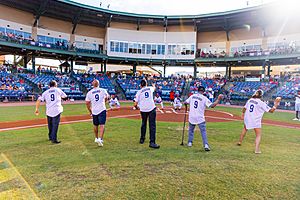Tougaloo Nine facts for kids
The Tougaloo Nine were a group of African-American students from Tougaloo College. In 1961, they took part in peaceful protests against unfair rules that separated people by race in Mississippi. They did this by holding "sit-ins" at public places.
Contents
The Fight for Equal Rights
The Civil Rights Movement was a big effort to gain equal rights for all people, especially African Americans, in the Southern United States. In Mississippi, this movement started slowly. Before the mid-1950s, most protests were about making sure black Americans could vote. Groups like the Mississippi Progressive Voters' League and the Regional Council of Negro Leadership were formed during this time. By the 1960s, more young people began to join the Civil Rights Movement.
A civil rights leader named Medgar Evers felt that Mississippi was too dangerous for protests at lunch counters. So, they chose the public library for their protest. Libraries were supported by taxes from both black and white people. The students were trained in peaceful protest methods. They were members of the NAACP Youth Council, led by Joseph Jackson Jr.
The Library "Read-in"
On March 27, 1961, the Tougaloo Nine first visited the George Washington Carver library in Jackson, which was for black residents. They asked for books they knew were not there. Then, they went to the main Jackson Public Library, which was only for white residents. There, they started a "read-in."
The nine students looked for books for their schoolwork. They sat down in the library and began to read. The library staff quickly called the police. The students were told, "There's a colored library on Mill Street.... You are welcome there." The chief of detectives told them that anyone who did not leave would be arrested. He asked who was leading the group, and Evelyn Pierce bravely said, "There's no leader." When the students refused to leave, they were arrested. They were charged with disturbing the peace for not obeying the order to leave.
The students faced a possible fine of $500 and six months in jail. The next day, March 28, the nine students were released after paying a $1,000 bond.
Protests and Support
The day after the read-in, hundreds of students from Jackson State Teachers College protested the arrest of the Tougaloo Nine. This demonstration included prayers, singing, and chants of "We Want Freedom." It lasted about 40 minutes. The president of Jackson State College, Jacob Reddix, was said to have attacked two protestors. He also threatened to remove students who protested from the college. Police used clubs and dogs against the students to break up the protest. No protestors were arrested that day.
The next day, March 29, over one hundred black community members gathered outside the courthouse. They wanted to show their support for the Nine. When the Tougaloo Nine arrived at the courthouse, the protestors applauded. Police then attacked the crowd with dogs and nightsticks. Medgar Evers, an NAACP representative, was beaten. Several women and children were also hurt. Two men were bitten by dogs, and an 81-year-old man suffered a broken arm. Reverend S. Leon Whitney, a local pastor, was also bitten by police dogs. Medgar Evers later said that this police action brought the black community closer together. It also made the NAACP the accepted voice for the community.
What Happened Next
The students went to court on March 29. They were not allowed to speak with their lawyers, Jack Young and R. Jess Brown, before their hearing. Each student was fined $100. They also received a thirty-day suspended sentence and a year of probation. This meant they would not go to jail if they did not take part in any more protests.
To protest the court's decision and the police violence, a meeting was held at a local Masonic Temple. At this meeting, Julie Wright encouraged other black community members to join a "No Buying Campaign." This campaign successfully boycotted white businesses that treated black people unfairly. These stores reportedly lost a lot of money in sales tax.
In 1962, partly because of this event, the American Library Association made a new rule. It stated that membership in the association must be open to everyone, no matter their race, religion, or beliefs. Because of this, four state chapters left the ALA: Alabama, Georgia, Louisiana, and Mississippi.
The Tougaloo Nine are not as widely known as other groups like the Freedom Riders or the Little Rock Nine. Sammy Bradford, one of the Tougaloo Nine, once said that it seems everyone else is celebrated, but not the people who started the civil rights movement in Mississippi. He felt they should be remembered for their brave actions.
In August 2017, a special historical marker was placed on the Mississippi Freedom Trail to honor the Tougaloo Nine. In May 2021, all nine members received honorary doctorates from Tougaloo College.
In July 2022, the Mississippi Braves baseball team and the Mississippi Civil Rights Museum honored the Tougaloo Nine. Players wore special 1960s-era Tougaloo College baseball jerseys with the names of the Nine on the back. Living members of the Tougaloo Nine threw out the first pitches. The jerseys were later sold to raise money for a scholarship at Tougaloo College.
The Nine Students
- Joseph Jackson Jr.
- Albert Lassiter
- Alfred Cook
- Ethel Sawyer
- Geraldine Edwards Hollis
- Evelyn Pierce (passed away in 2010)
- Janice Jackson
- James "Sammy" Bradford
- Meredith C. Anding Jr. (passed away in 2021)




